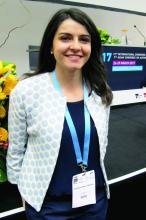MELBOURNE – Two-thirds of patients with active systemic lupus erythematosus responded to treatment with belimumab at 2 years in a clinical practice setting, particularly those with higher disease activity or polyarthritis, according to data presented at an international conference on systemic lupus erythematosus.
In a multicenter prospective study of 188 patients with active systemic lupus erythematosus (SLE), Maddalena Larosa, MD, of the University of Padova (Italy) and her colleagues reported a 71.3% response rate with belimumab (Benlysta) at 12 months based on achieving SLE Responder Index (SRI-4) criteria. SRI-4 is a composite endpoint requiring at least a 4-point reduction in SLE Disease Activity Index 2000 (SLEDAI-2K) score, no worsening (less than 10-mm increase) from baseline in the Physician’s Global Assessment of Disease Activity score (PGA), and no new British Isles Lupus Assessment Group (BILAG) Domain A and no more than 1 new BILAG Domain B scores.
The group had a 68.7% response rate at 24 months, which included 92% of the patients who responded at 12 months. Conversely, among nonresponders at 12 months, 87.5% of them still had not responded to the treatment by 24 months.Patients were treated with belimumab as an add-on to standard care, with a treatment regimen of 10 mg/kg at day 0, 14, 28, and then every 28 days. The mean SLEDAI-2K score among patients was 8.3, all were positive for double-stranded DNA autoantibodies, and the mean Systemic Lupus International Collaborative Clinics (SLICC) Damage Index was 0.84. Nearly two-thirds of patients were also being treated with immunosuppressants.
Patients with a SLEDAI-2K score of 10 or above were 25 times more likely to respond by 12 months and 12 times more likely to respond by 24 months, both of which were statistically significant.
Similarly, patients with polyarthritis – who constituted nearly half of all patients in the study – were 8 times more likely to respond at 12 months, and 32 times more likely to respond at 24 months. Patients on a prednisone dose of 7.5 mg/day or greater were also significantly more likely to respond at 24 months.
“What was surprising in these patients who respond better are patients with higher disease activity,” Dr. Larosa said in an interview, noting that many patients had also had refractory disease.
Belimumab treatment was also associated with a plateauing of damage accrual, as measured by the SLICC Damage Index, she said.
“In the 5 years before belimumab initiation, we observed an increase of damage accrual related to SLE, but after the first belimumab infusion we did not observe any increase of damage accrual related to the disease,” Dr. Larosa told the audience.
The median duration of treatment was 12 months, but 58 patients (30.9%) discontinued belimumab, mainly because of adverse events. Eight patients also discontinued because of pregnancy, and two because of remission.
In response to a question on the effect of treatment on flare, Dr. Larosa said the treatment was also associated with a reduction in the number of patients who experienced flares, and a significant reduction in renal flares in patients with renal involvement.
No conflicts of interest were declared.

